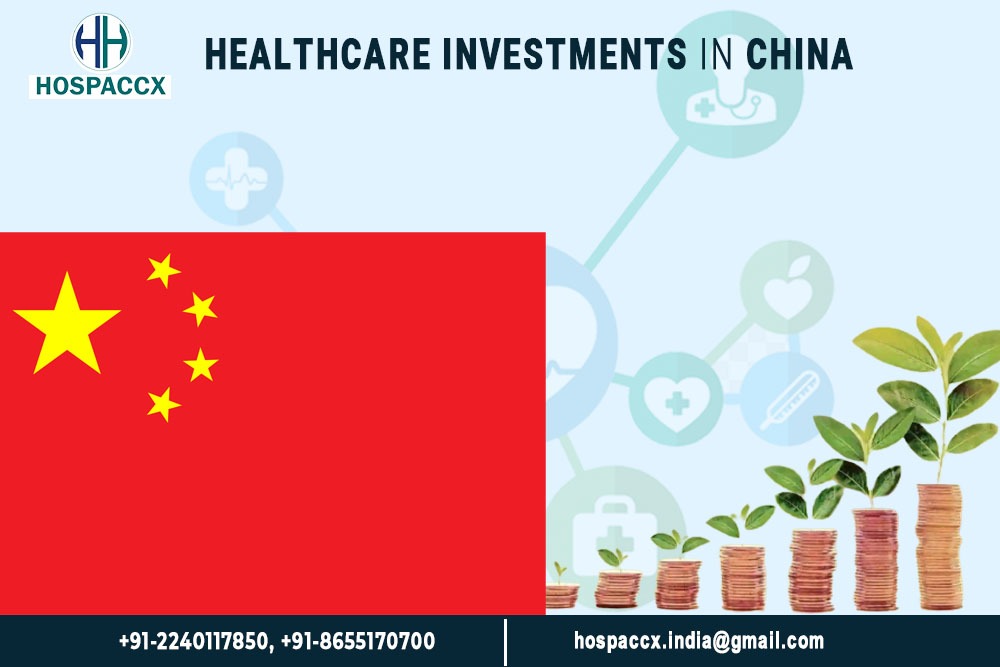Are you aware about China’s new opportunities for Healthcare Investments? Wouldn’t you like to know about the current needs for Investments in China’s Healthcare sector?
In this article, Hospacxx Healthcare Consultancy brings to you bites of information about the current needs for Investments in China’s healthcare sector, along with a gist of the investments initiatives been taken, that open the path for foreign investments and partnerships with private companies.
CHINA’S ECONOMY
Since the economic reforms of 1978, China’s economy has undergone a rapid growth through liberalization of Private businesses, foreign trade & Investments and relaxation of the state control over some commodity prices. According to a study by the International Monetary Fund, the encouragement for such economic changes for their key sectors, led to an average of 9% growth in their economy. Thereby indicating that privatization, foreign trade and FDI’s are the major contributors for their economic growth. The Chinese government further took measures to ensure a consistent economic growth through more investments into Industrial production & education of their workforce. With higher number of their workforce, it led to better productivity on Industrial advancement and Economic growth.
Today, China is the second largest economy and one of the largest countries for export of commodities due to a lower currency value. As of 2022, China has a Gross Domestic product of around 18.463 trillion U.S. dollars. Even though the growth rate of China’s real GDP gradually slowed down in recent years, the GDP growth rate managed to sustain at 5.1% in comparison to the 2021 GDP at 17.7 trillion.
HEALTHCARE INVESTMENTS IN CHINA
For the past 20 years, there has been fast growing changes in different sectors of the Chinese economy. Lately, these changes have been shifted to the healthcare sector as well. In 2020, the total expenditure on health care in China reached over 7.2 trillion yuan, which includes government spending, collective spending, and private out-of-pocket spending on health care.
With the increasing population growth, especially the ageing population & adaptation to an unhealthy lifestyle with altered diets and physical activity, led to increase in the disease burden on the healthcare systems due to high prevalence of non-communicable diseases like Stroke, Ischemic heart disease, Chronic obstructive pulmonary disease (COPD), Lung & Stomach cancer, Alzheimer’s disease and so on. Further, due to the increased demand for more affordable, accessible and high-quality healthcare services from the Chinese population, the government is under stress to fulfill the demands of the ever-increasing population.
These are the key factors for government’s focus on Chinese Healthcare Funding and their liberal views on inviting Foreign Investments and private healthcare businesses to grow at a large scale in the country.
INVESTMENT NEEDS IN PRIVATISATION OF HEALTHCARE SYSTEMS
According to a report by Asian Hospitals & Healthcare Management, the rapid rate of urbanization is driving growth and demand for healthcare and at the same time is putting huge pressure on China’s already weak healthcare system. Thus, many new opportunities are emerging for foreign companies interested in operating hospitals, clinics and care homes in China.
China already has five cities with a population of over 10 million: Beijing, Tianjin, Shanghai, Shenzhen and Guangzhou. But only about 54 per cent of China’s 1.4 billion population lives in cities, compared to 80 per cent in most developed countries. This will continue to create huge urban markets for healthcare of all types.
Private hospitals in China tend to be smaller than public hospitals. Almost 90 per cent of them have fewer than 100 beds, and there are very few large private hospitals with more than 500 beds. By contrast, more than half the public hospitals have over 100 beds, and there are 2,000 ‘Level III’ large public tertiary hospitals.
Rehabilitation and elder care are currently big growth areas, as the Chinese government is seeking to find ways to reduce the impending stress these areas are expecting, as demographic and disease profile changes take effect in the coming years.
Thus, meeting healthcare demands in the urban areas is already a huge challenge, but at the same time the government is aiming to improve healthcare in rural areas and creating opportunities for companies there. Though the health spending is much higher in urban areas, the share of spend in rural areas is now increasing.
Foreign investments in secondary healthcare systems have already started, with some organizations already pushing into tertiary care. The opportunities are now widening to include primary care, rehabilitation and elder care.
Many foreign hospital groups are now investing in China, including Columbia from the US, IHG, Optegra and Sinophi from the UK, IHH from Malaysia with its well-known Parkway brand, Raffles Group from Singapore, and Ramsay from Australia. And many of the facilities in creation are world class.
This current situation, with such a great need for new medical institutions, is a once in a lifetime window of opportunity for both local and foreign hospital groups and investors, as the scale of healthcare infrastructure that the country needs is huge.
While these trends are not unique to China—we see a similar pattern in India, Southeast Asia, the UK and the US for example—China’s healthcare services sector is struggling to cope with demand. In response, the government is now allowing greater scope for market forces to operate and opening up the private hospital sector to foreign investment to help relieve that pressure.
INVESTMENTS INTO PHARMACEUTICALS AND DIGITALIZATION
In the decade from 2000 to 2010, China was known to become the factory of the world. Foreign companies like Philips and Sanofi invested in manufacturing and selling pharmaceuticals and medical devices, both locally and for export, eventually coming to dominate the local branded pharma and medical device markets. But other sectors, including healthcare services, remained largely closed to foreign companies.
In a 2015 Global Growth Markets survey about Digital Health among hospital doctors and managers in China, and other countries in Asia, analysts found a very high level of support for digital health in China. In fact, it was the highest in the region, with 48 per cent of respondents saying that they believe various aspects of digital health are likely to improve patient outcomes in the next three to five years. The average for Asia as a whole was only 23 per cent.
China’s clinicians and hospital management have recognised health tech as one possible solution which could contribute to alleviating some of the huge challenges healthcare is facing in the country.
In the public sector, telemedicine is the technology which is attracting most attention, as national telemedicine initiatives are developed. But it is in the private sector that a much broader level of support for a variety of different digital health technologies is emerging. Most notably, China’s private healthcare sector decision-makers and influencers are getting behind health IT and interoperability, electronic medical records, diagnostic imaging and mobile health technologies. For example, medical imaging was mentioned by 75 per cent of respondents from private hospitals but only 53 per cent from public hospitals.
RECENT INVESTMENT INCENTIVES
The range of incentives for foreign investors is increasingly wide. Relaxing restrictions on foreign ownership is the starting point.
Reforms were first announced five years ago and investment momentum started to build in 2011, but it was only in 2014 that the government announced it would be reducing restrictions on foreign ownership in medical Joint Ventures (JVs) and collaborations. Later in the same year 100 per cent foreign ownership became possible, and the first wholly foreign-owned hospital was established by German company Artemedin in Shanghai Free Trade Zone.
In 2015 it was announced that 100 per cent ownership would be allowed in some select locations, namely Beijing, Tianjin, Shanghai, Jiangsu, Fujian, Guangdong and Hainan. Notably these are all major markets for healthcare services with rapidly expanding middle class and affluent populations possessing the means to spend on private healthcare services.
Thus, there are now financial incentives available, such as allowing capital from private equity and other sources, allowing equipment leasing rather than purchasing—which means lower up-front investment for hospital operators—and reimbursement from public insurance for care services provided by the private sector. It is also becoming easier to employ foreign doctors.
It is conclusive that with more investments, there can be a growth in the quality and accessibility of healthcare services & facilities, that would make it feasible to match to the healthcare demands of the Chinese population.
CONCLUSION
China’s Healthcare sector is slowly emerging as one of the key contributors for their economic growth, through the creation of many opportunities that would assist the government in filling the gaps in the accessibility and affordability of quality healthcare services to the general public.
Hospacxx Healthcare Consultancy, likewise, has worked across Indian and International States on Hospital Projects for Business Process Development, Service Quality Assurance, Financial Management and more. For more information, you can visit the company website on www.hospaccxconsulting.com or contact us directly .
Related Team Members










